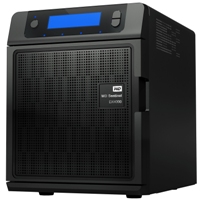Introduction
Here at TechwareLabs we’ve reviewed our fair share of NAS’s from manufacturers like Synology, LaCie and even Patriot. This is our first entry from Western Digital in this front though. Today we take a look at their Sentinel DX4000. This 4-bay NAS packs a whopping 12TB of storage to satisfy your data hoarding needs. Western Digital may know a thing or two about storage, but does this translate well into the appliance NAS market. Follow us as we take a look at how the Western Digital Sentinel DX4000 stacks up.

Specifications
- Intel Atom D525 1.8 GHz Dual-Core
- 2GB RAM
- Versions Available
- 12TB – WDBLGT0120KBK
- 8TB – WDBLGT0080KBK
- 6TB – WDBLGT0060KBK
- 4TB – WDBLGT0040KBK
- Interface – Gigabit Ethernet x2, USB 3.0 x2
- Height 8.1 Inches x Depth 8.80 Inches x Width 6.30 Inches
- Weight 10.7lbs 2-drive, 14.00lbs 4-drive
- Operating 41° F to 95° F
- Non-operating -40° F to 149° F
- AC Input Voltage 100-240 VAC
Features
Server Operating System
- Windows Storage Server 2008 R2 Essentials
Supported Client Operating Systems
- Windows XP with service pack 3, 32-bit versions only
- Windows Vista with service pack 2, all 32-bit and 64-bit platforms
- Windows 7, all 32-bit and 64-bit platforms
- File sharing support for Mac OS X 10.5.x, Mac OS X 10.6.x, Linux/Unix
Supported Web Browsers
- Internet Explorer
- Apple Safari
- Mozilla Firefox
- Google Chrome
Network Authentication
- Active Directory
Network protocols
- CIFS, NFS, HTTP, HTTPS, FTP, WebDAV
File Sharing Protocols
- CIFS/SMB, NFS, FTP, WebDAV
RAID Levels
- RAID 1 (2 drives only) and RAID 5 (3-4 drives)
- Automatic migration and capacity expansion


What makes you think this is a pci-e connection instead of just a similar form factor connector using Sata/SAS signalling ?
I am betting its the latter and they are not using a hardware raid chipset anywhere on this device. I want know more about the system to see if it is entirely software based. as it would be easy to force it to do a raid 0 setup if that were to be the case
When I read your comment I went ahead and disassembled the NAS again to make sure I hadn’t missed something. There is no discrete RAID chip connected on the backplane. It is instead using an Intel ICH9R chipset on the motherboard for hardware RAID. As far as the PCIe not actually being what it looks like, it appears that we may both be correct. Some motherboards are able to use their PCIe slots as SATA ports, but still retain PCIe functionality when a drive isn’t plugged in. I think that may be what they’re doing in this instance.
All that being said, I can’t really see the point in enabling a RAID 0 on a device like this. It’s main purpose is to keep data safe, something completely defeated when using RAID 0. I could see you wanting to use something like RAID 1+0 though.
Well with dual GBe and sudo software raid that the ich 9r provides you will probably limit throughput by the ich9r chipset or cpu.
In some situation with multiple people accessing large files at the same time performance can really degrade, so a raid 0+1 would provide better throughput because of less overhead in the parity calculations.
With some enhancements a raid 0+1 can read just as fast or faster than a 4 disk raid5 (again parity calculations, more read heads available with less processing overhead delays), just like in some cases a 2 disk raid 1 array can read faster than an identical single drive on the same controller (read optimization’s, more heads available).
I wonder how this device will perform in a realistic home use situation ( 2 parents 2 children, accessing multimedia content, dvd backups, home movies, and pictures ) or an office situation ( 5-10 people with office documents, access/quicken database, and pictures ) with 2 drives in raid 1 vs 4 drives in raid 5
For the performance you just included screen shots of the Windows transfer manager! LOL